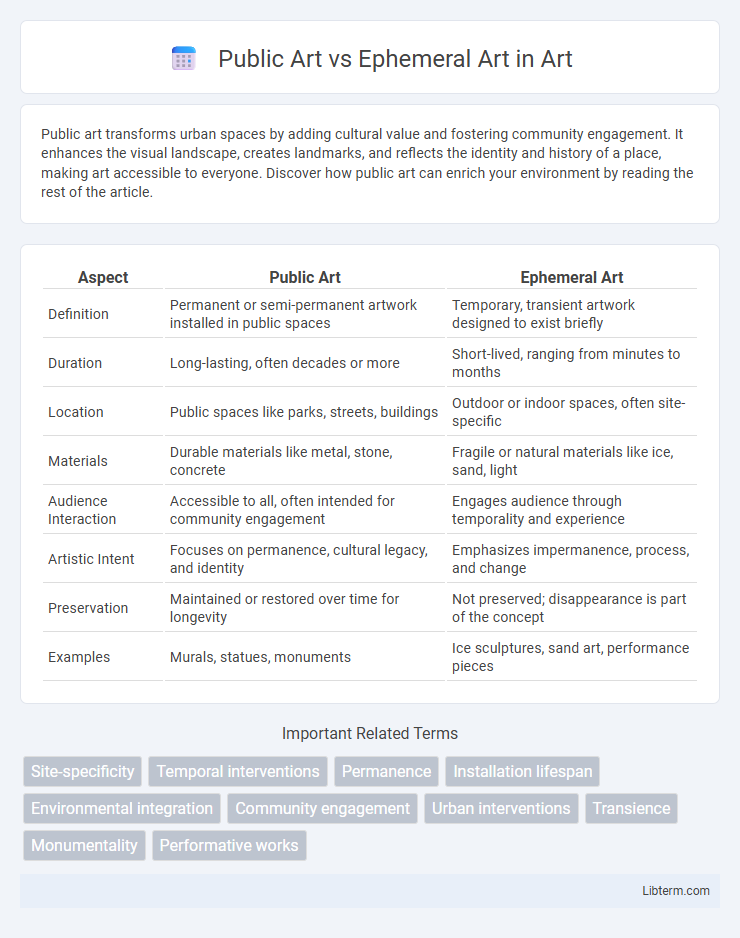Public art transforms urban spaces by adding cultural value and fostering community engagement. It enhances the visual landscape, creates landmarks, and reflects the identity and history of a place, making art accessible to everyone. Discover how public art can enrich your environment by reading the rest of the article.
Table of Comparison
| Aspect | Public Art | Ephemeral Art |
|---|---|---|
| Definition | Permanent or semi-permanent artwork installed in public spaces | Temporary, transient artwork designed to exist briefly |
| Duration | Long-lasting, often decades or more | Short-lived, ranging from minutes to months |
| Location | Public spaces like parks, streets, buildings | Outdoor or indoor spaces, often site-specific |
| Materials | Durable materials like metal, stone, concrete | Fragile or natural materials like ice, sand, light |
| Audience Interaction | Accessible to all, often intended for community engagement | Engages audience through temporality and experience |
| Artistic Intent | Focuses on permanence, cultural legacy, and identity | Emphasizes impermanence, process, and change |
| Preservation | Maintained or restored over time for longevity | Not preserved; disappearance is part of the concept |
| Examples | Murals, statues, monuments | Ice sculptures, sand art, performance pieces |
Introduction to Public Art and Ephemeral Art
Public art encompasses permanent or semi-permanent installations in public spaces, designed to engage communities and enhance urban environments through sculptures, murals, and monuments. Ephemeral art, by contrast, is characterized by its temporary nature, often created with materials that decay or transform, emphasizing the fleeting beauty and momentary experience. Both forms play crucial roles in cultural expression, though public art prioritizes longevity and lasting impact while ephemeral art highlights impermanence and temporal interaction.
Defining Characteristics of Public Art
Public art is characterized by its permanence, accessibility, and integration within communal spaces, often funded or supported by public institutions to enhance cultural identity and community engagement. These artworks are designed to withstand environmental conditions and remain on display for extended periods, serving as landmarks or symbols within urban or natural landscapes. Public art typically involves collaboration among artists, local governments, and communities, reflecting shared values and histories through sculptures, murals, installations, and monuments.
Understanding Ephemeral Art: Art That Fades
Ephemeral art refers to artistic creations designed to exist temporarily, emphasizing the transient nature of experience and memory. Unlike public art, which is often permanent and site-specific, ephemeral art embraces decay, change, or disappearance as integral to its meaning. This impermanence challenges traditional notions of art preservation and invites viewers to appreciate the fluid, momentary beauty of art in time.
Historical Contexts of Public vs. Ephemeral Art
Public art has historically served as a permanent cultural marker in urban spaces, reflecting societal values, political power, and communal identity over centuries. Ephemeral art, rooted in ancient rituals and performance traditions, emphasizes temporality and experience, often engaging audiences directly before fading away. The contrast between the enduring nature of public monuments and the transient quality of ephemeral installations highlights evolving attitudes toward artistic expression and public interaction throughout history.
Materials and Mediums: Durability vs. Impermanence
Public art employs durable materials such as bronze, stone, and concrete designed to withstand environmental elements and maintain longevity in urban spaces. Ephemeral art utilizes transient mediums like ice, sand, or organic materials that naturally decay or transform, emphasizing impermanence and temporal experience. The contrast in materials reflects their core purpose: public art for lasting cultural impact, while ephemeral art captures fleeting moments and dynamic interactions.
Audience Engagement and Community Impact
Public art fosters long-term audience engagement by becoming an integral part of communal spaces, encouraging continuous interaction and reflection. Ephemeral art captivates audiences through its transient nature, creating heightened emotional responses and a sense of urgency that prompts immediate community participation. Both forms of art significantly impact communities by enhancing cultural identity and inspiring dialogue, with public art offering enduring presence while ephemeral art drives dynamic, time-sensitive experiences.
Legal and Ethical Considerations
Public art often involves permanent installations that require permits, adherence to copyright laws, and compliance with local zoning regulations, ensuring legal clarity and long-term maintenance responsibilities. Ephemeral art, characterized by its temporary nature, raises unique ethical concerns regarding environmental impact, public consent, and the preservation of cultural heritage without necessarily demanding formal legal authorization. Both forms necessitate respect for community values and intellectual property rights, balancing artistic expression with societal norms and legal frameworks.
Cultural Significance and Interpretation
Public art serves as a permanent cultural landmark that reflects community values, history, and identity, often inviting diverse, ongoing interpretations from a wide audience. Ephemeral art, by contrast, embraces temporality and change, highlighting the transient nature of cultural moments and provoking immediate emotional or intellectual responses that fade with time. Both forms significantly shape cultural narratives but differ in their lasting physical presence and modes of engagement.
Challenges in Preservation and Documentation
Public art faces preservation challenges due to constant exposure to weather, vandalism, and urban development, which demand durable materials and ongoing maintenance strategies. Ephemeral art, characterized by its fleeting existence and use of transient materials, poses significant documentation difficulties since its physical form is temporary and often site-specific. Effective preservation of both art forms requires innovative documentation methods, such as high-resolution photography, 3D scanning, and detailed archival records, to capture their cultural and historical significance beyond physical survival.
The Future of Public and Ephemeral Art
Public art continues to evolve through technological integration, enhancing community engagement and accessibility while maintaining permanence in urban landscapes. Ephemeral art leverages temporality and environmental interaction, embracing digital mediums and augmented reality to create immersive, transient experiences that challenge traditional notions of art preservation. The future of both public and ephemeral art lies in hybrid models that combine lasting physical installations with dynamic, time-sensitive digital elements, fostering inclusive cultural dialogues and adaptive urban aesthetics.
Public Art Infographic

 libterm.com
libterm.com